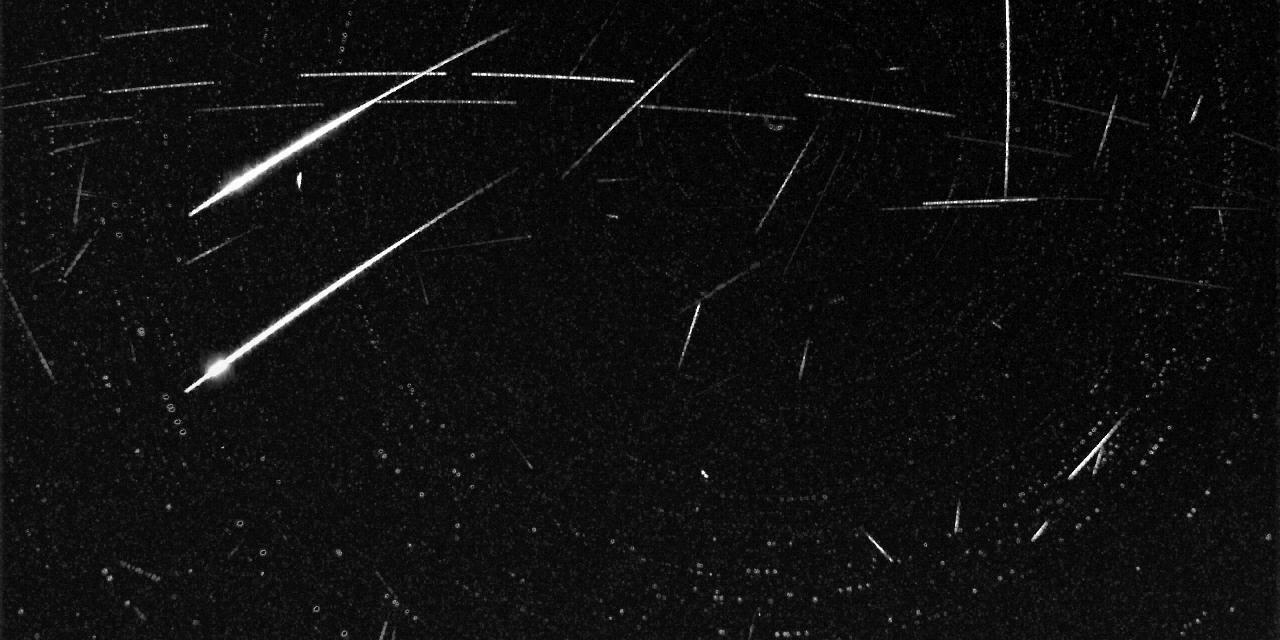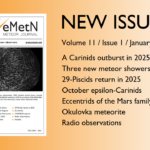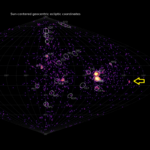Two fireballs appeared above Belgium within a time period of 36 minutes on 2020 April 1, at 22h57m20.8s and 23h33m26.7s UT. Both were registered by cameras of the CAMS BeNeLux network, the Global Meteor Network, the FRIPON all-sky network and radio stations of the BRAMS network. The orbits did not fit with any known stream and the similarity between both orbits indicate rather that these were two independent sporadic events.
1 Introduction
The stacked image of RMS camera BE0001 installed in Grapfontaine at Observatoire Centre Ardenne (OCA) showed two bright parallel meteor trails that caught immediate attention (Figure 1, bottom). Seen from a single station such parallel appearance is often just an effect of perspective. When the results of RMS camera BE0003 installed in Genk at Cosmodrome showed the same two fireballs also parallel to each other (Figure 1, top), it was obvious the trajectories were really parallel in our atmosphere and thus had their radiant close to each other.
The first fireball appeared at 22h57m20.8s UT, the second one at 23h33m26.7s UT, about 36 minutes apart. Although the trajectories of the fireballs occurred within a small part of our atmosphere, the pre-atmospheric particles were far apart in space as Earth moved about 65000 km on its orbits in between the two times of appearance.
2 The trajectory and orbit
The event at 22h57m20.8s UT was also registered by four FRIPON all-sky cameras at Rouen (FRNO05), Oostkapelle (NLWN02), Liège (BEWA01) and Brussels (BEBR01). The second event at 23h33m26.7s UT was registered by three FRIPON all-sky cameras at Brussels (BEBR01), Oostkapelle (NLWN02) and Liège (BEWA01). The orbital elements obtained by FRIPON are compared with those obtained by CAMS and the Global Meteor Network in Table 1 and Table 2.
The RMS cameras 3814 and 3815 also serve as BE0001 and BE0003 in the Global Meteor Network for which the trajectories and orbits are calculated independently. The results obtained by the GMN can be consulted online (https://globalmeteornetwork.org/data/). The first fireball appeared nicely in the FoV of both BE0001 in Grapfontaine and BE0003 in Genk, while the second fireball was caught entirely on BE0001 but only partially in the corner of the FoV of BE0003.
GMN has a very decent orbit for the first fireball of 22h57m20.8s UT, while the 23h33m26.7s UT event resulted in a hyperbolic orbit. The less accurate result for the second can be explained as a result of the unfavorable registration in the corner of the FoV on one camera. Although the CAMS orbits are based on positional data from several cameras at different stations, CAMS coincidence results for both fireballs in a hyperbolic orbit. (See Table 1 and Table 2).
Table 1 – Orbits of the fireball of 1 April 2020 at 22h57m20.8s UT as obtained by CAMS BeNeLux (Carl Johannink) compared to GMN (Denis Vida) and FRIPON (François Colas).
| CAMS | GMN | FRIPON | |
| αg | 245.1° | 245.7° | 245.2° |
| δg | +29.9° | +30.0° | +30.4° |
| Hb | 101.7 km | 99.8 km | – |
| λb | 4.9438° E | 4.9158° E | – |
| φb | 50.3745° N | 50.3711° N | – |
| He | 68.74 km | 70.1 km | – |
| λe | 4.3746° E | 4.3902° E | – |
| φe | 50.3566° N | 50.3509° N | – |
| vꝏ | 47.8 km/s | 46.7 km/s | – |
| vg | 46.5 km/s | 45.1 km/s | 46 km/s |
| a | ꝏ | 19.9 A.U. | 12.6 A.U. |
| q | 0.7563 A.U. | 0.7559 A.U. | 0.7550 A.U. |
| e | 1.0448 | 0.9620 | 0.940 |
| ω | 238.41° | 239.81° | 240.33° |
| Ω | 12.3977° | 12.3997° | 12.400° |
| i | 74.81° | 73.88° | 73.47° |
| TJ | – | 0.56 | 0.71 |
Table 2 – Orbits of the fireball of 1 April 2020 at 23h33m26.7s UT as obtained by CAMS BeNeLux (Carl Johannink) compared to GMN (Denis Vida) and FRIPON (François Colas).
| CAMS | GMN | FRIPON | |
| αg | 252.7° | 252.8° | 252.7° |
| δg | +27.4° | +27.2° | +27.3° |
| Hb | 126.25 km | 119.4 km | – |
| λb | 4.7686° E | 4.6445° E | – |
| φb | 50.7757° N | 50.7724° N | – |
| He | 75.67 km | 78.5 km | – |
| λe | 3.8518° E | 3.8849° E | – |
| φe | 50.7815° N | 50.7771° N | – |
| vꝏ | 51.5 km/s | 51.2 km/s | – |
| vg | 50.3 km/s | 49.7 km/s | 51 km/s |
| a | ꝏ | ꝏ | 83.97 A.U. |
| q | 0.8085 A.U. | 0.8032 A.U. | 0.8030 A.U. |
| e | 1.0511 | 1.002 | 0.990 |
| ω | 231.17° | 232.58° | 232.78° |
| Ω | 12.424° | 12.424° | 12.424° |
| i | 84.85° | 84.6° | 84.98° |
| Tj | – | 0.09 | 0.16 |
Although the ground projections of the trail appear remarkable parallel to each other (Figure 13) and also the entrance angle differed only few degrees, the orbits as listed in Table 1 and Table 2 do not fit well for the similarity criteria. With DD ~0.1 and DSH ~0.24 the criteria are at the very limit of what could point at a common origin. None of both orbits fit with any known stream in the IAU meteor shower list. The two fireballs are likely sporadics which appeared by pure chance within a small portion of the atmosphere in a time range of 36 minutes.
The velocity of both fireballs is close to the hyperbolic limit, in such case the slightest inaccuracy on the measured duration and or position can make the difference between a high eccentric ellipsoid and a hyperbolic orbit. Figures 14 and 15 display the height profiles and intensity profiles with all measured points for both fireballs for each camera involved. These profiles agree very well and reveal no significant mistakes.
3 The radio echo data
The fireballs were also detected by the radio observers network BRAMS. The event at 22h57m20.8s produced only a weak overdense echo which was only detected by stations in the eastern part of Belgium, barely visible for stations in the center and nothing at all at stations in the western part of Belgium (Figure 16). The 23h33m26.7s event caused a much stronger echo, saturating some receivers and registered by most BRAMS stations except for those in the west of Belgium (Figure 17) (source Hervé Lamy).
Acknowledgment
The author wishes to thank François Colas for providing the FRIPON data, Hervé Lamy for providing the BRAMS data, Carl Johannink for providing the CAMS data, Denis Vida for making available the Global Meteor Network orbit data and last but not least all the participating camera operators in the BeNeLux CAMS network who contributed to this result.


Figure 1 – The stacked images of RMS camera BE0003 (top) and BE0001 (bottom). The first fireball (22h57m20.8s UT) is at right middle on BE0003 and the upper one at left on BE0001, the second fireball (23h33m26.7s UT) is in the upper right corner on BE0003 and the lower one at left on BE0001.

Figure 2 – The fireball of 22h57m20.8s UT as registered on CAMS 804 in Zoersel, Belgium (credit Bart Dessoy).

Figure 3 – The fireball of 22h57m20.8s UT as registered on CAMS 808 in Mechelen, Belgium (credit Luc Gobin).

Figure 4 – The fireball of 22h57m20.8s UT as registered on CAMS 3814 in Grapfontaine, Belgium (Adriana and Paul Roggemans).

Figure 5 – The fireball of 22h57m20.8s UT as registered on CAMS 3815 in Genk, Belgium (Adriana and Paul Roggemans).

Figure 6 – The fireball of 23h33m26.7s UT as registered on CAMS 3914 in Grapfontaine, Belgium (Adriana and Paul Roggemans).

Figure 7 – The fireball of 22h57m20.8s UT as registered on CAMS 3900 in Nancy, France (credit Tioga Gulon).

Figure 8 – The fireball of 23h33m26.7s UT as registered on CAMS 3900 in Nancy, France (credit Tioga Gulon).

Figure 9 – The fireball of 23h33m26.7s UT as registered on CAMS 380 in Wilderen, Belgium (credit Jean-Marie Biets).

Figure 10 – The fireball of 22h57m20.8s UT as registered on CAMS 814 in Grapfontaine, Belgium.

Figure 11 – The fireball of 22h57m20.8s UT as registered on CAMS 815 in Grapfontaine, Belgium.

Figure 12 – The fireball of 23h33m26.7s UT as registered on CAMS 815 in Grapfontaine, Belgium.

Figure 13 – The trajectories of both fireballs projected on the ground, the 22h57m20.8s UT event is marked in yellow, the 23h33m26.7s UT event is marked in red. The FoV for the 10 cameras involved have been intersected at 90 km elevation and projected to the ground.


Figure 14 – The CAMS height profile (top) and intensity profile (bottom) for all the cameras involved with the fireball of 22h57m20.8s UT.


Figure 15 – The CAMS height profile (top) and intensity profile (bottom) for all the cameras involved with the fireball of 23h33m26.7s UT.

Figure 16 – Spectrogram of the BRAMS station in Humain with the echo of the 22h57m20.8s UT event in the middle (just left from the strongest one) (credit Hervé Lamy).

Figure 17 – Spectrogram of the BRAMS station in Overpelt with the echo of the 23h33m26.7s UT (credit Hervé Lamy).





